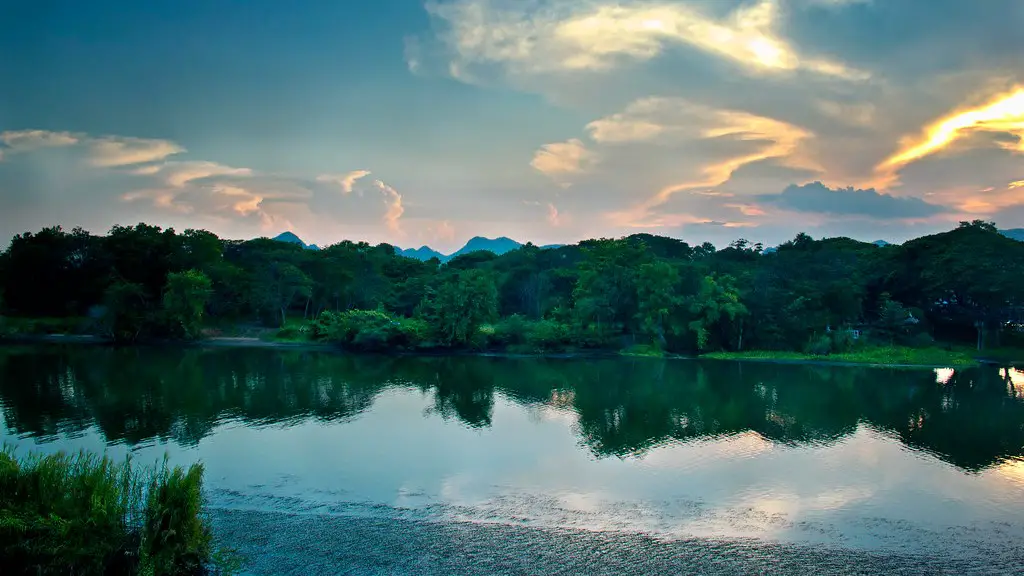The Mississippi River is indisputably one of the great rivers of the world. Its winding course of over 2,500 miles has been the source of endless fascination for generations of Americans. But where did it go? And what role does it play in the country’s history and culture?
The Mississippi River starts in northern Minnesota and flows southward, winding its way through 10 states before it reaches its termination point in the Gulf of Mexico. Along its journey, the river serves as an important economic artery, the drainage source for 40 percent of the U.S., the lifeblood of numerous towns, cities, and communities, and an invaluable source of recreation.
As the largest natural river in the United States, the Mississippi has been a source of nourishment and commerce for millennia. The Native Americans of the region were some of the first to use the river as a means of transportation, fishing, and trading. European explorers arrived in search of mineral resources and to increase their empires. Mississippi River, as well as its tributaries, proved to be invaluable in the growth and success of the United States since its inception.
How does the current Mississippi River compare to its historical past? Environmental experts suggest that much of the river is vastly different because of manmade development and excessive water withdrawals. Massive damns, extensive levees and sea walls, and irrigation systems have altered the watershed. Its physical characteristics are altered, wildlife and vegetation has shifted, and there is increased sedimentation in certain areas.
The river has also become home to some non-traditional inhabitants. Invasive species, such as the Asian carp, have found a place in the river and are rapidly taking over. This species threatens native fish and has introduced unwanted and hazardous commercial fishing practices. Contamination due to agricultural runoff, as well as industrial and domestic waste, has been a major issue affecting the Mississippi.
Despite all its issues, the river remains an integral part of the United States. Its influence can be seen in classic works of literature such as Mark Twain’s Huckleberry Finn. The Mississippi also serves as an essential infrastructural connection for millions of people. Perhaps the most testament to the river’s dramatic impact is the enormous demand for its waters for shipping, agriculture, industry, and recreation.
Mississippi River Usage
The Mississippi River is essential for a number of different uses. More than 600 million tons of cargo are transported annually on the river, and there are more than 10,000 locks and dams along the river. In addition, the river is a major source of water for many states, providing drinking water to millions of Americans.
The river is also an important source of revenue, as it attracts thousands of tourists every year who want to experience its beauty and explore its many secrets. Fishing, kayaking, and boating are popular activities, and people come from all over the world to take part.
The Mississippi River is also embraced by many Native American tribes, who see the river as a source of life and sustenance. Many of these tribes continue to live along and near the river, taking advantage of its resources while respecting its power and beauty.
Historical Impact
The Mississippi River has played a crucial role in American history. It was a major mode of transportation in the 18th and 19th centuries, and it was integral to Westward Expansion. The river was also the battleground for many different wars, including the infamous Battle of New Orleans in 1815 and the strategic struggle between France and Britain during the Seven Years’ War.
Perhaps the most significant event in modern history that was related to the Mississippi River was the Civil War. After the Union blocked the South’s access to the river during the war, the Confederacy lost access to a majority of its resources and the North gained a strategic advantage over the South. This ultimately resulted in the end of slavery, and the Mississippi River is seen by many as the backdrop to this iconic moment.
Environmental Challenges
The Mississippi River is facing a number of environmental issues. Pollution is a major threat, as runoff from agricultural fields, industrial waste, and domestic sewage have all been detected in the river. The excessive withdrawal of water from the river has also caused water levels to drop and has caused serious ecological damage.
Invasive species, such as the Asian carp, are also a major issue. These species can outcompete native fish, and their numbers are increasing rapidly due to their ability to reproduce quickly and survive in changed conditions. Over-fishing is another problem, as some commercial fishers take advantage of the abundance of fish in the river and deplete the natural resources.
Governmental Response
The United States has taken steps to protect the environment of the Mississippi River. The Clean Water Act has established laws that prohibit the dumping of pollutants into the river. The Department of Agriculture has implemented conservation measures to regulate the use of water from the river and reduce sedimentation. The Army Corps of Engineers has also implemented several strategies to control water levels and maintain the health of the river.
In addition, there have been several awareness campaigns that have been put in place by both governmental agencies and private organizations. These campaigns educate people on the importance of the river and its need for protection. There are also numerous volunteer groups that work to restore and protect the river and its habitats.
Conclusion
The Mississippi River is an integral part of the United States. It plays an important role in our history, commerce, and culture. Despite the many environmental issues facing the river, it remains a source of life and sustenance for millions of people. The United States government is taking steps to protect the river and its resources, but more needs to be done to ensure its future.




